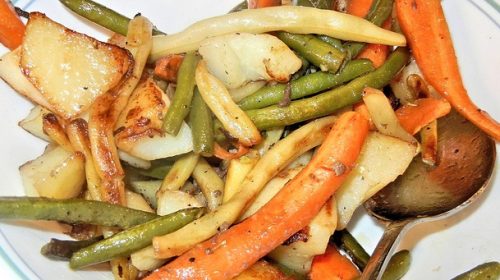Some content may contain affiliate links to products which means we could earn a fee on your purchase. Thank you for visiting
Whether you’re feeding a homemade diet or just looking for a few healthy options for livening up your dog’s daily dish, vegetables definitely have a place at the dog table.
Which Vegetables are Best for Adding to Dog Food?
First and foremost, the best veggies to give your dog are the ones that are safe for dogs, followed by the ones he’ll actually eat and not just “eat around.”
Most dogs (not all) will happily eat roasted vegetables such as
- squash
- carrots
- bell peppers
- cauliflower
- brussel sprouts
- broccoli

Beyond this list, we’ll cover other ways to give your dog vegetables and we’ll also review the unsafe veggie list and precautions when feeding raw.
Can You Feed Your Dog Too Many Vegetables?
Yes, while dogs are omnivores like we are, too many vegetables in the diet could cause gas, bloat and lead to hunger. There are also seeds to consider such as those found in squash and cucumbers which could irritate your dog’s GI tract if eaten in excess.
The best approach to take when trying to incorporate healthy snacks is to have a variety of vegetables with and without seeds and of different colors. That way, your veggie treats will be more naturally balanced.
After awhile, your dog’s bathroom business will tell you exactly which vegetables they can’t digest properly. Simply adjust these vegetables as you learn how your dog handles each vegetable.

Are Fresh Vegetables Good For Dogs?
Some fresh veggies are good: yes. If your dog enjoys a crunchy vegetable such as carrot or celery consider yourself lucky! Dogs can be given the occasional raw, fresh vegetable such as a carrot, celery stalk or cucumber. Carrots and celery, in particular, can help clean the gum line of dogs who enjoy “chewing” their vegetables.
Other vegetables such as squash and brussel sprouts should not be given to your dog for raw eating because they are too hard to digest. But you can definitely blanch or roast them for an extra special dog treat.
A good rule of thumb is to ask yourself if you would eat the vegetable raw. If not, don’t give it to your dog raw.
Broccoli, beans and cauliflower can be eaten raw, but digest better when blanched or cooked.
Precautions for Raw, Fresh Veggies
Don’t give carrots or celery stalks to gulpers. Aside from the choking hazard, raw vegetables are harder to digest. A dog who gulps his food without chewing could experience extreme gastro-intestinal upset if they have to digest a whole carrot.
Always make sure you are present and paying attention while your ‘chewer’ dog enjoys his carrot.
When giving a celery stalk as a dog treat, peel the tough, stringy layer of the outer portion so your dog can chew right through the stalk without the fibrous strings. Those strings can tickle the throat or cause irritation and/or gagging.
Best Vegetables for Homemade Dog Food
These vegetables work well, providing your dog can digest them without issue:
- Carrots
- Celery
- Zuccini
- Yellow Squash
- Pumpkin
- Beans (Green, Yellow, Wax)
- Bell Pepper (Never HOT peppers)
- Brocolli
- Cauliflower
As for potato and pea, we consider them a starch and not a vegetable. If you want give it to your dog, it has to be cooked and given in strict moderation due to the sugar conversion. Sweet potato is recommended over white potato and boiled is healthiest.
Can Dogs eat Canned or Frozen Vegetables?
It’s best to avoid giving canned vegetables to a dog because canned vegetables could contain way too much sodium for your dog to safely handle. Frozen vegetables are a great option when preparing a dog’s meal, just make sure they are plain, frozen vegetables and not in a spicy or oily, buttery sauce.
I make homemade dog food in large quantities and freeze it on a monthly basis. I shop the sales and of course try to buy in season when vegetables are in abundance.
However, when shopping out of season, frozen bagged vegetables are a solid back up plan when making my dog’s meals.
Dog Food Made Fresh Daily
So if you’re making your dog’s food on a daily basis and enjoy the same vegetables as your dog, you could just make life easy and eat the same veggies on a daily basis as long as they are not covered in butter or other unnecessary fats.
Most dogs prefer their vegetables roasted in the oven with a tiny bit of coconut oil or olive oil just as you would make for yourself.
When roasting (cooking) you have a lot more options because the vegetables become easier for your dog to digest.
- Brussel Sprouts
- Broccoli
- Cauliflower
- Bell Pepper (Not HOT)
- Squash
- Beans
- Carrots
Best Veggies for Freezing Dog Food

If you’re feeding a raw diet or freezing meals (like I am) you’re better off with sticking with vegetables that freeze well in their raw form (or blanched).
My dog’s favorite veggies that freeze well (for a dog’s meal) are squash, carrots, broccoli, cauliflower and spinach.
Cucumbers, celery and other lettuces turn into a wet mess and brussel sprouts overpower the entire meal as they thaw. For that reason, I only give my dog cooked, roasted brussel sprouts and do not add them to his dinners for freezing.
If you’re interested in raw diet info check my post: Raw Diet for Beginners. I go over the 3 popular ways to introduce raw food and make the transition.
What Vegetables are NOT good for Dogs?
Do NOT feed dogs these vegetables in their cooked or raw form:
- The entire Onion family: Onions, green onion, scallions, chives, leeks.
- Garlic
- Avacado (not any part)
- Tomato (stem and parts near stem)
- Mushrooms
- Peppers (bell okay)
How to Prepare Vegetables for Dogs
Clean
Always clean vegetables the same way you would if feeding them to a child. Your dog cannot process pesticides any easier than we can.
Peel
Peel celery strands and any tough, soil growing vegetables just as you would for personal consumption.
Roast or Blanch
If you have time, you can roast vegetables twice per week and store them in the fridge for healthy, tasty treat options. Simply cut them a little larger than bite size (most will shrink), drizzle a tiny amount of olive or coconut oil and roast them until tender at 375-400.
If your dog will eat vegetables boiled then by all means go ahead and boil them.
As long as you don’t overcook them, they’ll retain a good amount of their nutrients so your dog gets the total benefit of a healthy treat option.
Final Thoughts
Having a stash of veggies for your dog is a really smart and healthy way to be able to feed your dog several treats a day without all the calories or fillers found in commercially packaged offerings.
Every day, more and more dog foods and treats are being recalled for contaminated meat or other added ingredients. You can definitely take the stress out of dog treats by making some of your own.
Vegetables are easy to make and far healthier for your dog than other treats with fillers, chemicals and preservatives. This is one area where you can take control of your dog’s health for very little time and cost. Have fun and enjoy the process!
Thanks for visiting SeniorDogDays!
Dear Valued Reader,
We’re trying a new approach. Maybe you didn’t notice but throughout this article, you weren’t bothered by annoying popup ads begging for your email address. And that’s because Senior Dog Days is on a mission to keep dogs safe without making you watch videos or share your email before giving you the important information you’re looking for.
If you appreciate this approach and can spare a buck we promise to put it to good use. All donations go right back into this site and cover expenses that we pay out of pocket all for the love of dogs.
There is no such thing as a small donation.
Thanks for helping!
[wpedon id=2028]
.

